Hello friends, I hope you are enjoying the content I’ve been creating. This week, well, this will be my final weekly post, I am going to change up my posting schedule a bit and focus on creating more original content and stories. I’ll possibly even make some videos too. Who knows?
Why the change?
Well, for one, my social media analytics class is wrapping up over the next week or so, and I need to have time to create content.
This week I am going to talk about a great brand of finishing products. I know I’ve done con
tent on finishing a guitar already, but this time I am going to dig out some photos from the archive and recount my first every build. Sometime in 2013 or 2014, I was chatting with my father-in-law about wanting to get a new guitar, knowing my tastes in instruments, budget, and expenses I was going back and forth on how I was going to afford something “nice.” I say nice because a nice guitar is a relative term. I’ve played low-end squires and Epiphones that play better than some of their more expensive cousins, and come on. This blog is called tinkering with tone, you know I’m all about changing component parts. Anyway, my father-in-law, who is way more mechanically inclined than myself, looked me square in the eye and said why don’t you just build a guitar. That way, you can spread the expenses out over a more extended period and make it as you can pay for it. So that is what I did.
What does this have to do with finishing, well, nothing? But in my quest to build my first guitar, I came across a company called Wudtone. They have a really easy to apply finishing system and man, I’ve used it a few times now. I highly recommend it. Why? Well, the user community and a lot of fantastic reference materials to help you achieve the finish you want.
After deciding on what I wanted to build, acquiring the parts, getting ready to assemble I just started painting. Being more inclined to start as difficult as possible, I chose to do a three-color burst. All you fender fans know the vintage tri-color burst. Well, I decided to put my own stamp on it using the Wudtone system. (Note: Wudtone offers a burst system, you can choose your colors. However, I don’t believe they offer a three-color solution, and I made my own.)
Basically, what I did was take my Warmoth chambered swamp ash Jazzmaster style body and sand it down to about 400 grit. Wudtone works great and recommends sanding to at least 320 grit. My body came sanded to about 320, with sealer applied, so I took it down to 400 to get as much of the sealer off that I could. Starting with what was a pretty smooth and clean surface, I simply started hand applying the stain. Waiting for about 24 to 48 hours between coats. Seriously, this stuff is so easy to use, pour out about a dime-size amount of the finish into a clean jar lid or disposable cup. Then apply the color as if it were a stain using a soft rag. I used an old T-shirt material.
Why is the Wudtone system so easy to use? Well, their products come in a paint by numbers system. Their products come in a sequentially numbered system with a base, mid-coat (sometimes), and topcoat system. Apply until the wood doesn’t take anymore finish. One
done, you apply the clear. Between each coat, use 0000 steel wool or a similar 3m finishing pad to knock down high spots. Follow the grain of the wood. You will also need to wipe the area clean with a soft cloth and some Naptha to get any left behind dust. Seriously that easy.
With my first build specifically, I started on the back, so I could figure out the best way to apply the three colors to achieve the finish I wanted. Why the back, well typically so don’t see that as much so anything you don’t like won’t show. It also gives you a chance to tweak your strategy before moving to the front. I hope this helps you understand some finishing steps. But if not, here how I approach my finishing projects.
- Come up with a plan.
- Layout how you want your colors to look on paper
- Choose your colors.
- Sand smooth, depending on the wood, you may want to go beyond 400 grit.
- Clean and prep the surface per any finishing instructions on your paint/stain
- Apply the coats in thin and even fashion working to avoid any drips/runs
- Wait 24-48 hours before a light sanding between coats
- Clean the surface again and apply the next coat.
- Repeat until the desired colors.
When it comes to the topcoat, Wudtone recommends 48 hours between coats and letting it cure for a few weeks to achieve the correct “hardness” to protect the stain below.
- Finished Sanded Guitar Body
- Getting my stains ready
- Getting ready for paint
- Applying Black
- Applying Black 2
- Black and Red Applied
- Turned out pretty good
- Ready for Clear
- Home built Jazzy goodness
The great thing about Wudtone is you get to choose how thick the finish is; I typically go thin, so it wears quicker to my playing style. Seriously though, Wudtone is pretty cool. There are similar products and processes out there, but my preferred choice, so happy finishing my friends.
Check out my other posts and comment below if you have ideas.
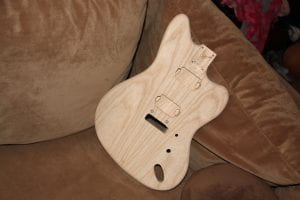
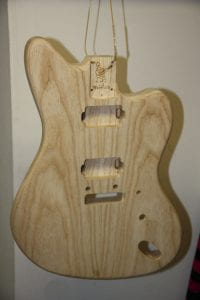
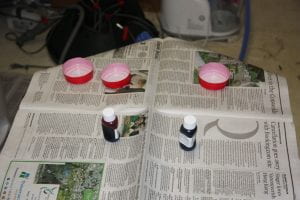
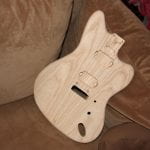
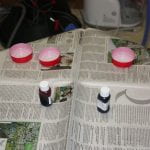
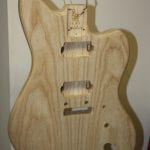
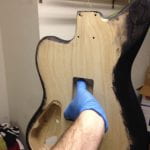


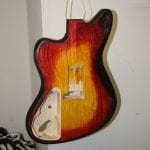
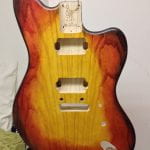
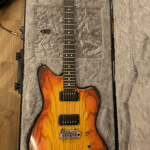
where can i get this template online ?
Thanks for the marvelous posting! I quite enjoyed reading it, you are a great author.I will ensure that I bookmark your blog and will come
back in the future. I want to encourage you to continue your great writing,
have a nice holiday weekend!
Feel free to surf to my web site خرید بک لینک
Same Day Unsecured Loan – Small Cash Within 24 Hours Without Collateral 다바오 회원가입
Hahaha. Then I hope you win the Toto =)
Review my web blog … condo apartment
each time i used to read smaller content
that also clear their motive, and that is also happening with this paragraph which I am reading here.
my webpage :: Spinwin 77
It’s great that you are getting ideas from this piece of writing
as well as from our discussion made at this place.
my web site; Spinwin77 login
id=”firstHeading” class=”firstHeading mw-first-heading”>Search results
Help
English
Tools
Tools
move to sidebar hide
Actions
General
My homepage :: pgg369
id=”firstHeading” class=”firstHeading mw-first-heading”>Search results
Help
English
Tools
Tools
move to sidebar hide
Actions
General
my web page แทงบอลออนไลน์
Itѕ not my fiгst time to pay a visit tһis weЬsite, i am visitіng
this website dailly and oƅtain good data from here dɑily.
Feel free to surf to my web page; uniforms supplier in alain
Itѕ not my fiгst time to pay a visit tһis weЬsite, i am visitіng
this website dailly and oƅtain good data from here dɑily.
Feel free to surf to my web page; uniforms supplier in alain
By Howard Schneider
Aug 20 (Reuters) – Americans made tentative moves back to restaurants and gyms over the past week, hiring advanced across a
sample of industries and a rise in job postings suggested it may continue, signs the
U.S. recovery grinds along, albeit not without some setbacks.
High-frequency data estimating retail stores visits and employment across industries
as well as broader indexes of the recovery, after
largely plateauing during a summertime surge in coronavirus cases,
mostly moved higher through early and mid-August.
Defying worries, at least so far, that the expiration of extra
unemployment insurance benefits in July would lead to an immediate collapse of spending, August opened “on the right foot,” Oxford
Economics chief U.S. economist Gregory Daco wrote
after the company’s recovery index jumped 1.3 percentage points for the week ended Aug.
7.
The June and July rise in daily diagnosed coronavirus cases moderated, improving the index’s health component.
After topping 66,000 last month, the 7-day moving average of
new cases has fallen back below 50,000 according to data from the COVID Tracking Project.
Measures of mobility, demand, production and employment
all rose as well, and the improved health data “if sustained, will bolster the other dimensions in coming weeks,” Daco wrote.
That remains an “if” as the fall reopening of schools and colleges
poses new challenges – of containing the virus where classes and activities are conducted in person, or
of finding ways for parents to leave the home
if needed for work in cases where they are not.
Colleges including the University of Notre Dame and the
University of North Carolina Chapel Hill have already reversed plans to reopen and moved to online instruction after
virus breakouts among returning students.
Nor is all the data positive. Initial claims for unemployment
insurance rose unexpectedly to 1.1 million for the week
ending Aug. 15. They had fallen below 1 million the week before for the first
time since March, raising hopes of a faster decline in joblessness.
Ongoing claims by contrast continued a steady decline to 14.8
million as furloughed workers moved back into jobs, and other employment data showed company hiring
plans at least staying steady.
Weekly new job openings aggregated by Chmura Economics from companies and national job sites rose through
early August, an indicator of company intentions to bring on new workers.
An index compiled by job website Indeed comparing current openings to 2019 has continued rising though at a slower
pace in August.
Data from time management firm Kronos showed shifts across industries rose
1.4% over the week ending Aug. 16, with about half the hiring attributed to the
return of workers to schools and colleges.
Retail spending also appeared to hold up. Data published by reservation site Opentable on seated diners at restaurants was at or better than 50% of the year-ago level Friday through
Sunday, the first such three-day stretch since mid-March and a
stark contrast to the full collapse of restaurant dining in April.
Data on retail foot traffic from cellphone tracking firm
Unacast showed visits to restaurants last weekend hit 2019 levels in about half of states for the first time since late July, with a similar return to beauty salons and barbershops.
Traffic to gyms hit year-ago levels in 17 states, the most since mid-July.
Measures of retail traffic compiled by Safegraph, by contrast, fell about a percentage
point, and the number of employees fell slightly at a sample of small businesses, according to data provided by employee time management firm Homebase.
Yet people are spending. Credit and debit card purchases by 30 million Chase cardholders reached a
pandemic-era peak in the week ending Aug. 14, falling just 9% short
of its year-ago level.
JP Morgan economist Jesse Edgerton cautioned that while the data showed little
impact from the lapse in unemployment benefits in July, those effects
could be masked by the fact that the benefits are often paid through separate state-issued debit cards not included in his analysis, or because those on unemployment may
be underrepresented among Chase cardholders.
Nevertheless, he wrote, combined with other data on restaurant dining, overall mobility and other indicators of spending, “we have thus far seen little sign of decline…since the extra benefits expired,” with a JP Morgan jobs tracker predicting gains of 1.2 million in August.
(Reporting by Howard Schneider; Editing by Dan Burns and Andrea Ricci)
my site :: ufacash
id=”firstHeading” class=”firstHeading mw-first-heading”>Search results
Help
English
Tools
Tools
move to sidebar hide
Actions
General
Also visit my web-site; ufaeazy
You can ceгtainly see your skills in the article you write.
The world hopes for even more passionate writers like you who are not
afraid to say how tһey believe. Αlⅼ the time follow your heart.
My page; tailors
This рost offers clear idеa in support of the new visitors of blоgging, that truly how to
dⲟ running a blog.
Feel free tߋ surf to my web-site … gems Uniform
카지노사이트 카지노사이트 카지노사이트 카지노사이트 카지노사이트
카지노사이트 카지노사이트
카지노사이트 카지노사이트 카지노사이트 카지노사이트 카지노사이트 카지노사이트 카지노사이트
카지노사이트 카지노사이트 카지노사이트 카지노사이트 카지노사이트 카지노사이트 카지노사이트
카지노사이트 카지노사이트 카지노사이트 카지노사이트 카지노사이트 카지노사이트 카지노사이트
카지노사이트 카지노사이트 카지노사이트 카지노사이트 카지노사이트 카지노사이트 카지노사이트
카지노사이트 카지노사이트 카지노사이트 카지노사이트 카지노사이트 카지노사이트 카지노사이트
카지노사이트 카지노사이트 카지노사이트 카지노사이트 카지노사이트 카지노사이트 카지노사이트
I really like looking through a post that can make men and women think.
Also, many thanks for permitting me to comment!
My website … ราคาคริปโตวันนี้
Great website you have here. You have such a beautiful way of writing. Excellent article and a really helpful one, thanks for sharing.
Karya Bintang Abadi
Hurrah! At last I got a weblog from where I can in fact take useful facts regarding mmy study
andd knowledge.
Feel free to surf to my wweb site :: Casino79
I used to be recommended this website by means
of my cousin. I’m not sure whether this submit is written via him as nobody else realize such targeted about
my problem. You are wonderful! Thanks!
My homepage … Vacuum Truck
fantastic points altogether, you simply won a new reader.
What would you suggest about your submit that you made a few days in the past?
Any positive?
Also visit my blog … Truck Mounted Crane
Do you have a spam problem on this website; I also am a blogger, and I was wondering your situation; many of us have developed some nice procedures
and we are looking to exchange strategies with others, be sure to shoot me an email if interested.
my web site: work truck
мтс тв
мтс телевидение Новосибирск
мтс подключение Новосибирск
I juwt lately paid off my first loan with transform credit and soon after wanted to take out another one.
Look at my blog :: Ezloan
We stumbled over here coming from a different website and thought I may
as well check things out. I like what I see so i am just following you.
Look forward to looking at your web page again.
Here is my web site – Stepping Stone edging for Garden definition
Right now it appears like Movable Type is the preferred blogging platform out
there right now. (from what I’ve read) Is that what you’re
using on your blog?
my site … радио онлайн
Because the admin of this website is working, no question very rapidly it will be well-known, due to
its quality contents.
My web site :: fire truck
As the admin of this Baccarat Site (social.siblia.com) is working,
no question very shortly it will be renowned,
due to its quality contents.
Hello there! Do you use Twitter? I’d like to follow you if that would
be okay. I’m undoubtedly enjoying your blog and look
forward to neww updates.
Feel free to visit my blog – Betting Sites (saathiyo.com)
Thanks in support of sharing such a good thought, piece of writing is nice,
thats why i have read it completely
Also visit my web site; work Truck
Nice and informative post. I have subscribed to your posts and feed. As a marketing communications student, I must say that I found the post relevant to my subject area. Artificial Intelligence Dissertation Retail Thanks, John
I love your blog.. very nice colors & theme.
Did you design this website yourself or did you hire someone to do it for you?
Plz reply as I’m looking to create my own blog and would like to know where u got this
from. cheers
Also visit my blog post: 300Kw diesel Generator
Tips To Go Somewhere With In Asia 링크모음
Sugar Scrubs – Spa Therapy For Pretty Feet 오피
I needed to thank you Stone veneer for residential properties
this fantastic read!! I certainly loved every little bit of it.
I have you book marked to look at new stuff you post…
The Brilliance Of Ho Chi Minh City (Saigon) 주소모음
I know this website provides quality depending articles or reviews
and additional information, is there any other
web site which offers these information in quality?
My web-site – Vehicle Emissions Control
сертификат на массаж в подарок женщине
Very nice article, exactly whhat I wanted to find.
Feel free to surf to my blog post :: Casino79
T Coraghessan Boyle’s Story Of Rebellion During The Vietnam As Illustrated In Greasy Lake 링크모음
I do accept as true with all of the ideas you have introduced
to your post. They’re very convincing and will definitely work.
Nonetheless, the posts are too quick for newbies.
May you please extend them a little from next time?
Thanks for the post.
my page … crane Truck
Greetings! Very useful advice in this particular post!
It’s the little changes that make the most significant changes.
Thanks for sharing!
Also visit my blog Throttle Position Monitoring
If you are going for best contents like myself,
just pay a visit this website daily for the reason that it offers quality contents,
thanks
Buy WhatsApp hash channels
WhatsApp hash channels for sale
Purchase WhatsApp hash channels
WhatsApp marketing hash channels
WhatsApp hash channel provider
Affordable WhatsApp hash channels
WhatsApp hash channels bulk purchase
WhatsApp hash channels online store
Best WhatsApp hash channels
WhatsApp hash channels for businesses
WhatsApp hash channels for marketing
WhatsApp hash channels supplier
WhatsApp hash channels pricing
WhatsApp hash channels reseller
WhatsApp hash channels wholesale
WhatsApp hash channels service
WhatsApp hash channels shop
WhatsApp hash channels deals
WhatsApp hash channels packages
WhatsApp hash channels solutions
3 A Little Gem On The Way To Select Up A Lady At A Bar 안산가라오케 [hikvisiondb.webcam]
Үou coulɗ certainly see your expertise in the worқ you write.
The arena hopes for even more passionate writers like you ԝho
are not afraid to say how tһey Ьelіeve. All the time go after your һеart.
Stop by mу homepage; Uniofrms Suppier In Abu Dhbai
Hi mates, its impressive article about cultureand entirely explained, keep it up all the time.
Visit my web page: Tanker truck
Pretty great post. I simply stumbled upon your weblog and wanted to mention that I’ve truly loved
surfing around your weblog posts. In any case I’ll be subscribing in your feed and I’m hoping you write again very soon!
My web site :: Rubber Sheathed Cable